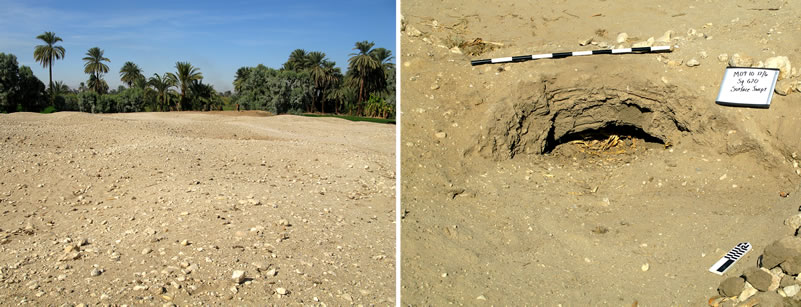Site M08-09/S1
During the course of the first and second seasons of the Mo‘alla Survey Project, we examined a site approximately eleven kilometers south of the necropolis on the east bank of the Nile, which we designated M08-09/S1.1
The current extent of surface ceramic and subterranean architectural remains at M08-09/S1 is about 3.7 hectares,2 atop and within a terrace of wadi-deposited gravels (Figure 1); this terrace, which probably once extended over a much larger area with extensive settlement and cemetery remains, has mostly been quarried away to create cultivable land.

The remaining ancient remains appear to coincide with the necropolis “north of Ezbet Mahmoud” (about 300 meters to the south of M08-09/S1) that Sayce partially excavated in 1905.3 Even by Sayce’s time, the site had been “systematically and scientifically plundered,” but his examinations of the remains uncovered Early Dynastic, Eleventh, and Twelfth Dynasty burials; several of the tombs contained mud-brick vaults, and the remains of one such sepulchral vault is still visible on the surface of M08-09/S1 (Figure 2). The ceramic descriptions accompanying Sayce’s short report are vague, but based on the presence of pottery with black-painted bands and line-and-dot decoration, several of his “Twelfth Dynasty” tombs probably belong instead to the Eighteenth Dynasty. The collection of surface remains at M08-09/S1 appears to confirm such a supposition.

Surface collection of ceramic material at M08-09/S1 allows one to refine Sayce’s description of the burials and their significance for this region of the Third Nome. In addition to the more limited periods reported by Sayce, ceramics spanning the late Predynastic Period through the New Kingdom are present at the site. Earlier ceramic material includes the rim to neck of a rolled-rim storage jar of late Predynastic date (Figure 3a; Marl A1) and a Meidum bowl (Figure 3b; Marl A1, polished interior and exterior). Small vessels of Nile silt and Marl A3 dating to the First Intermediate Period and Middle Kingdom are present, such as “baggy”-shaped jars (Figure 3c; Marl A2, with abundant limestone and coarse sand inclusions).4 New Kingdom ceramics are represented primarily by storage jars, including a rim-to-neck (Figure 3d; Nile B2) with parallels from the mid-Eighteenth Dynasty,5 and the base of an ovoid jar (Figure 3e; Marl A3 variant6). Among other notable surface finds is a sherd from a black-topped red-ware bowl with an impressed pattern of square dots across the entire surface of the sherd (Figure 4);7 the form and surface treatment find parallels in A-Group,8 C-Group,9 and Kerman contexts, and this particular type of decoration on polished bowls may be characteristic of Nubian pottery of Old Kingdom date.10
Sayce’s excavations recovered a funerary cone that records the name and titles of a priest of Hathor of Agny, Aapehty, an artifact that led Gardiner to equate Sayce’s cemetery site (e.g. M08-09/S1) with the town of Agny.11 The chronologically wide-ranging surface remains at M08-09/S1, and the lack of a superabundance of specifically funerary remains there, suggest that in addition to a cemetery the site once contained habitation remains, although most of the settlement site is probably now lost. Based on the topographical lists, M08-09/S1 indeed corresponds well to the location of ancient Agny, while one should seek the site of Hefat in the northern portion of the mouth of the Wadi Falij el-Hunud, roughly between the modern Nag‘ el-Hanadi and Nag‘ el-Hamidat. Further survey in this area, particularly the desert terraces where additional ancient remains might still be extant, is a goal of future seasons.
Notes
- 1. Although it does not appear on any modern maps, local people refer to the site as “Zurghani.”
- 2. According to local ghaffirs who now guard the site, ten years ago, the ancient remains covered an area at least three times larger.
- 3. Sayce, ASAE 6 (1905): 159-167.
- 4. Compare Dorothea Arnold., “Keramikbeispiele aus den Gräbern der frühen 11. Dynastie von El-Tarif,” MDAIK23 (1968): 51-54, 65.
- 5. Parallels include David Aston, Barbara Aston, and Donald Ryan, “Pottery from Tombs in the Valley of the Kings, KV 21, 27, 28, 44, 45 and 60,” CCÉ 6 (2000): 20-21 and fig. 61; Guidotti and Silvano, La ceramica del tempio di Thutmosi IV, 90-91, nos. F33, F34, and F41.
- 6. The fracture of this dense, sandy marl fires with distinct pink/yellow zoning; numerous examples of this fabric appear along the roads of the desert west of Thebes, particularly in Second Intermediate forms (cf. Darnell and Darnell, BCÉ 18 (1994): 46-47); further investigation of this fabric is required and comparison will be made with Marl A3, Marl A4, and the intermediate fabric “E9” in Seiler, Tradition & Wandel, 37.
- 7. The decorative pattern on the sherd corresponds most closely to Hans-Ake Nordström, Neolithic and A-Group Sites (SJE 3:2; Lund, 1972), vol. 2, pl. 25, Group 1, No. 6; Säve-Söderbergh, ed., Middle Nubian Sites, 38, fig. 17, 1:1.
- 8. Bruce Williams, The A-Group Royal Cemetery at Qustul: Cemetery L, OINE III Chicago, 1986), 83, fig. j.
- 9. Bruce Williams, C-Group, Pan Grave, and Kerma Remains at Adindan, Cemeteries T, K, U, and J, OINE V (Chicago, 1983), pl. 4b (the caption dates the sherd as “IA,” although the list on 61, table 26 gives a date of “III”) and pl. 92C (dated to IIA, but the description on 55 as a sherd with “a very thick rim,” distances this example from the sherd published here).
- 10. Brigitte Gratien, “La Basse Nubie à l’Ancien Empire: Égyptiens et Autochtones,” JEA 81 (1995): 51-51 (type B), 54-55 (with numerous parallels, some of which are cited in the previous footnotes).
- 11. Alan Gardiner, Ancient Egyptian Onomastica II (Oxford, 1947), 12*-14*
